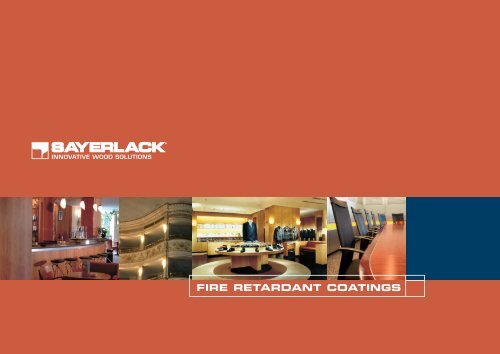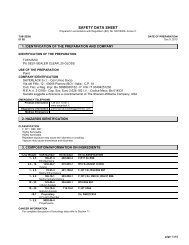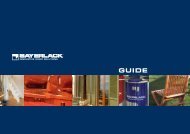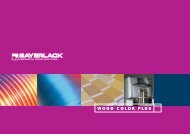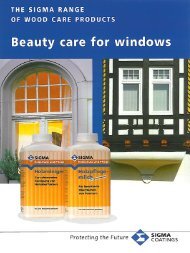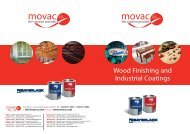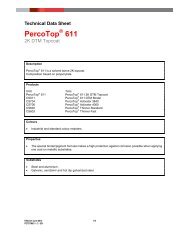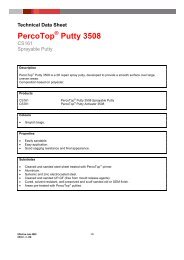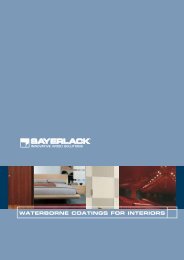Sayerlack Fire Retardant Coatings - Movac Group Limited
Sayerlack Fire Retardant Coatings - Movac Group Limited
Sayerlack Fire Retardant Coatings - Movac Group Limited
- No tags were found...
You also want an ePaper? Increase the reach of your titles
YUMPU automatically turns print PDFs into web optimized ePapers that Google loves.
FIRE RETARDANT COATINGS
CONTENTSpag. 3pag. 4pag. 6pag. 7pag. 9Objective: reducing fire propagation timesProtection from fire: where is it required?<strong>Fire</strong> reaction<strong>Fire</strong> retardant systemsPolyurethane products for interiorsWaterborne coatings for interiors
OBJECTIVE:REDUCING FIRE PROPAGATION TIMESAfter a fire starts, any reduction in the propagation of flames can be decisive in saving human lives. One ofthe purposes of fire retardant coatings is to reduce the rate at which the fire spreads and thereby retardit. As regards fire protection, most countries have very strict regulations concerning the performance offire-resistant and fire-retardant coatings, especially for the treatment of bearing structures, coatings andwooden works.Wood exhibits an important aesthetic importance and fire retardant coatings for wood should combinefire protection with excellent aesthetic results. “Safety performance and Finish performance”. Customers’requirements are not only regulation-related (compliance with law), but they are also appearance/functionalrelated.These are two components that since the design stage have been at the basis of <strong>Sayerlack</strong>’s progresstowards the realisation and formulation of fire retardant coatings.When it is mandatory to conform to fire regulations, the architect/designer or authoriser issuer of thefire certificate may calculate the fire load (quantity of flammable material per square metre and relevantcalorific power) for each room, assessing the class that each construction element falls into, based onemergency exits, fire fighting systems, or internal permanent safety services.Protection from fire:where is it required?• Public buildings• Offices/factories• Clubs, bars, pubs and dance halls• Banks• Airports and railway stations• Hotels and tourist facilities• Exhibition centres, meeting and fair venues• Shops• Schools, colleges, universities and nursery schools• Auditoriums, theatres, cinemas and museums• Hospitals• Gyms and fitness centres• Churches• Civil buildings3
<strong>Fire</strong> reaction - Test UNI 9174A) Test start on MDF coated with anormal polyurethane cycle.AA1) The 750 C° heat of the radiantpanel sets the coating film on fire.B) Test start on MDF coated withthe TB cycle.BB1) Even if only partly damaged, thereaction that reduces the combustionspeed is evident on the panel.FIRE REACTIONM.D. 26/6/84 - M.D. 6/3/92 (UNI 9796) - Ministry of Internal Affairs Italy<strong>Fire</strong> reaction regulations divide coating and panelling related materials, as well as flooring, false ceiling,furnishing and seating surface materials, into several classes. Italian regulations, one of the strictest in theEU in terms of fire reaction performance, assigns six classes. They are assigned a fire reaction class, whichranges from 0 (non-flammable) to 5 (easily flammable). In the event of a fire in a closed place, temperaturereaches very high values. Wooden materials start to release gases that considerably contribute to firepropagation. Class 1 is the best to protect the material involved in the fire. The <strong>Sayerlack</strong> Class 1 fireretardant systems effectively slow down fire spreading time, as they act with several mechanisms atthe same time. For example, an MDF 4 mm thick panel with reaction class 4, after treatment with the<strong>Sayerlack</strong> fire retardant cycle, obtains the reaction class 1. Our certifications were awarded by the <strong>Fire</strong>Department - Central Technical Prevention and Safety Direction of Roma Capannelle.<strong>Sayerlack</strong>’s fire retardant products will be tested in the near future also in accordance to new Europeanregulations (Euroclass), this to allow prompt introduction on the market.<strong>Fire</strong> reaction test based on UNI 9174Flame propagation speed300250200A2) Without protection, the flamereaches the wood.B2) The combustion sets off but theflame propagation speed is greatlyreduced by the fire retardant coating.seconds15010050< 30/mm/Min00 50 100 150 200 250 300 350 400 450 500 550 600 650 700millimetresRaw MDF panel4A3) The panel is 50% charred.B3) The situation is almost unchanged,the damaged area is minimal andthe flame tends to extinguish.MDF panel coated withthe “TA” system
Abrasion test,TABER-UNI 9115/87Wet heat resistance test,EN 12721/97FIRA Report: TMCMF03296Temperature °C557085Assessment533RemarksNo damageDisc just visibleDisc just visibleSurface Resistance to coldliquids, EN 12720/97FIRA Report: TMCMF03296LiquidEthanol 48%TeaCoffeeCold Oils (24h)Cold Fats (24h)TestAssessment55555AssessmentRemarksNo damageNo damageNo damageNo visible damageNo visible damageResistance to Mechanical DamageBS3962 Part 6:1980FIRA Report: TMCMF03296RemarksWOOD FOR STRUCTURALUSE IN BUILDINGThe fire behaviour of load bearing woodenstructures, which requires passive protection,is totally different from that of metal structures.In the event of fire, the temperature reachedin a closed room is of several hundreds degrees.Metal, an excellent heat conductor, at temperaturesover 450º C softens and loses all mechanicalresistance, and virtually “collapses”.Wood, a bad conductor, does not collapse: flamesand heat carbonise it’s surface, which limits thepropagation of combustion to the outer layers.Intumescent coatings increase such protectivelayer as when heated, they cause a swelling of thecoating film (several centimetres) which acts asa barrier to fire.This is why wood is increasingly used in currentengineering and architectural works.Dry heat resistance test,EN 12722/97CrosscutScrape: SurfacepenetrationScrape: Penetrationto Substrate555Cuts smooth8.7N20.6NTemperature °C557085100120Assessmentnot performed5543Remarks-FlawlessFew isolatedLight halo visible fromdifferent directionsLight resistance test,UNI 9427/89Exposuretime (hours)20Grey scaleevaluation5RemarksFlawless5
FIRE RETARDANT SYSTEMSTATBTCTDSystemClear polyurethane, 450 gr/m 2White polyurethane, 450 gr/m 2Pigmented polyurethane, 450 gr/m 2White, waterborne, 400 gr/m 2Certification AchievedClass 1 fire reaction according to M.D. 6/3/92 - UNI 9796Ministerial homologation no. BO1159PVI100001 of 15/11/96Class 1: BS 476 - Part 7 – Solid Oak, birch multilayer ply and pineveneered on MDF (United Kingdom)Class O: BS 476 - Part 6 – on Class O treated substrateUNE 23.727-90 Clasificaciòn M1 - expediente n. 3008471 - placasde fibrocemento (España)Class 1 fire reaction according to M.D. 6/3/92 - UNI 9796Ministerial homologation no. BO1159PVI100002 of 18/02/97Class 1: BS 476 - Part 7 - Class 1 – on birch multilayer plyClass O: BS 476 - Part 6 – on Class O treated substrate.Class 1 fire reaction according to M.D. 6/3/92 - UNI 9796Ministerial homologation no. BO1159PVI100003 of 22/02/00Class 1 fire reaction according to M.D. 6/3/92 - UNI 9796Ministerial homologation no. BO1159PVI100004 of 05/09/00System to obtain the class 2 fire reactionaccording to D.M. 26/6/84CABE 61 Clear polyurethane, 450 gr/m 2 Ministerial homologation no. BO502B11CD200001 of 27/04/88AComparison between fire retardant (A) and intumescent (B) cycleBSystem required to achieve M1 Class reaction-to-fire statusbased on French standard NF P92-501TU 74** Clear acrylic polyurethane sealer-topcoat. Use 20% TH 790 hardener and add 5% of XT 500 additive. Apply 2 coatsof 120g/m 2 .Coating systems, during spray application can lose 20-30% of product due to “overspray”. We recommend increasingthe purchase quantity of the final product by the same percentage in order to ensure the substrate receives thecertified quantity. Losses due to sanding can also occur; sanding should therefore always be very light.6
POLYURETHANE PRODUCTS FOR INTERIORSTA system – Class 1 fire reaction 1M.D. 6/3/92 & BS476 P7 - 450 gr/m 2TU 22TZ 22**Clear polyurethane basecoat – two 150 gr/m 2 coats cured at 50% with TH 222Clear polyurethane topcoat – one 150 gr/m 2 coat cured at 50% with TH 222The system exhibits an excellent transparency (even at such heavy applied weights) and good scratch resistance,with the possibility of choosing between a 10 or 25 gloss mat topcoat or a 75 gloss semigloss topcoat. It can beused by spray or curtain coater for a highly professional use to meet the aesthetic and functional requirementsof architects and designers.TB system – Class 1 fire reaction 1M.D. 6/3/92 & BS476 P7- 450 gr/m 2TU 22/13TZ 2225/13White polyurethane basecoat – two 150 gr/m 2 coats cured at 50% with TH 333Mat white polyurethane topcoat – one 150 gr/m 2 coat cured at 50% with TH 333The cycle exhibit excellent flow and covering. It features good scratch resistance and excellent finish.It’s available in two versions: a 25 gloss mat topcoat or a 75 gloss semigloss topcoat.TC system – Class 1 fire reaction 1M.D. 6/3/92 - 450 gr/m 2TU 22/13TZ 22**White polyurethane basecoat – two 150 gr/m 2 coats cured at 50% with TH 333Clear polyurethane topcoat – one 150 gr/m 2 coat cured at 50% with TH 333+ 40% max of polyurethane paste TP 4140/XXIf a pigmented finish is required featuring excellent appearance, the “TC” cycle (a compound of basecoat andmat or semigloss binder + pigmented pastes TP 4140/XX at 30%) is the most appropriate system to use: thousandsof colour shades are possible with just 12 polyurethane pastes. Perfect for interior decorators and designers.7
Base colours of theTP 4140/XX seriespolyurethane pastesThe stains in the table may be subject to alterations over time; so, their values are only approximate.TP 4140/C4 TP 4140/A8 TP 4140/B8 TP 4140/B2TP 4140/B6 TP 4140/A5* TP 4140/C9 TP 4140/A2TP 4140/B3 TP 4140/B9 TP 4140/A1 TP 4140/C7N.B.: neutral binders of the “TC” cycle are available at 10 and 25 gloss (mat) and 75 gloss (semigloss) but with the addition of some types ofpolyurethane pastes, the gloss level may slightly change.* Black A5 does not have high opacity and should only be used for stain recipes, or mixed with other bases. If you need a lacquered black, use pasteTP 4140/57.CABE 61 system – Class 2 fire reaction 1M.D. 26/06/84 - 450 gr/m 2TU 280TZ 3325Clear polyurethane basecoat – two 150 gr/m 2 coats cured at 50% with TH 755Mat polyurethane topcoat – one 150 gr/m 2 coat cured at 50 % with TH 755The system, applied on beech multilayer ply for wall panels, is comparable to an normal polyurethanefinishes, both for ease of application and for the final result; in fact, the finish features excellent smoothnessand transparency. Drying times are similar to a normal polyurethane without whitening problems.8
WATERBORNE COATINGS FOR INTERIORSTD system – Class 1 fire reaction 1M.D. 6/3/92 - 400 gr/m 2AF 22/13Mat white waterborne topcoat – two 200 gr/m 2 coats (including 20% of tap water)The “TD” waterborne system meets the requirements of exhibition stand organisers that need a quick and easyto apply product. With only two coats, for 400 gr/m 2 total (330 gr/m 2 + water) you can obtain a Class 1 fire reactioncoating. As it is free from solvents, the product can be used for applications and/or retouches in places (suchas fairs, museums, tunnels) where flammable coatings cannot be used. Also with the “TD” cycle you can obtainstains by adding 3% of XA 2006 series waterborne paste to the AF 22/13 white product.Below are the mixtures obtained.The stains in the table may be subject to alterations over time; so, their values are only approximate.XA 2006/06 XA 2006/08 XA 2006/17 XA 2006/21XA 2006/42 XA 2006/52 XA 2006/53 XA 2006/61XA 2006/72 XA 2006/BBXA 2006/26XA 2006/69Mixtures withwaterborne pastes,XA 2006/XX seriesN. B.: the white topcoat of the “TD” cycle is only available in the 5 gloss version (matt) but, if some kinds of water-based pastes are added, itcan slightly change.9
Courtesy of Galata Museo del Mare, GenovaProcedure to issuethe Statement ofConformity(Certificate of Supply)At the end of the work, the painter must fill in a pre-printed form (Statement of application – provided by <strong>Sayerlack</strong>when the order is placed). The form is used to state the use of the homologated basic weight for the specific fireretardant cycle. The filled in form shall be faxed to <strong>Sayerlack</strong>, which shall issue a Statement of Conformity, valid for5 years. This process may vary slightly depending on the EU member state the product is in use.N.B. <strong>Fire</strong> services or interested authorities, in certain EU member states may ask for an update even if thecertificate has not expired, if the item is damaged or chipped. We can only issue certificates for the squaremetres corresponding to the homologation: the owner (with the old but still valid certification) shall haveto prove to any inspectors that the new certificate is for maintenance only.After several objections by the manufacturers of homologated coatings, a second edition of the UNI 9796standard was issued in January 1998. Compared to the previous edition, an ageing cycle has been addedsubject to a series of tests, so when a standard is mentioned, the most recent edition is the valid one.With this amendment, the 5 year expiry has been eliminated.For those who have never performed these works we suggest that you always ask for the room specificationswith the <strong>Fire</strong> services specification, so as to prevent any unpleasant situations.10
Certificationsfor <strong>Sayerlack</strong>fire retardantcoatings11
09/2011Z02A06UK<strong>Sayerlack</strong> is a brand ofSherwin-WilliamsSAYERLACK S.r.l.Export DepartmentVia del Fiffo, 12 - 40065 Pianoro (BO) - Italiatel. +39 051 770511 - fax +39 051 770528export@sayerlack.it - www.sayerlack.comTechnical Service: tel. +39 051 770770fax +39 051 770521 - customerservice@sayerlack.itSHERWIN-WILLIAMS UK COATINGS LtdA1 Business Park - KnottingleyWest Yorkshire - WF11 OBU - Englandtel. +44 (0) 1977 673363 - fax +44 (0) 1977 673521info@sayerlack.co.uk - www.sayerlack.co.ukTechnical Service: tel. +39 051 770770fax +39 051 770521 - customerservice@sayerlack.itSAYERLACK, A brand of SHERWIN-WILLIAMS920 Midland - 101 West Prospect AvenueCleveland, OH 44115 - USAtel. +1 800 52405979 - fax +1 216 566 1293info@sayerlack.com - www.sayerlack.comTechnical Service: tel. +39 051 770770fax +39 051 770521 - customerservice@sayerlack.itSAYERLACK SINGAPORE PTE. LTD.Blk 26, Ayer Rajah Crescent#07-01, Singapore 139944tel. +65 6763 7789 - fax +65 6763 0252infoasia@sayerlack.com - www.sayerlack.comTechnical Service: tel. +39 051 770770fax +39 051 770521 - customerservice@sayerlack.it


